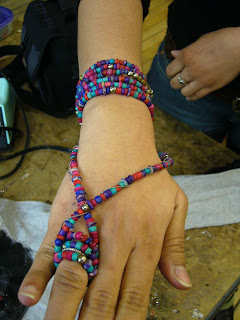Fashion by George Simmel
The reading throws light on how fashion rises out of the need of humans to differentiate and stand apart but yet not be excluded out of the society circle. It interesting to know that though as human beings we are easily demarcated as male or female, each of us have within us a united masculine and feminine principle. This I reminds me of an avatar that we in classical Indian dance form associate with creation, the " Ardhanareswari" avatar which is represented by a being who’s body is made up of two halves; one the male half and the other being the female half.
His association of the word fashion with two contrasting ideas , one being the act of camouflaging of oneself, to be accepted into the folds of the society and the other to stand apart from those who do not belong to the same class in the society, has become the very basis of the class and society. More interestingly how the people who are more visibly in the society, are usually those who have camouflaged well, never seem to deviate from the general opinion, in a way don’t dare to think independently, almost like they do not want to identify with their individuality and prefer to stick to the ways of the world. Fashion is about creative imitation and yet demarcation among peers, whether it is in the well defined societies of the modern world or among the tribal clans that are untouched by the modern ways. The only difference is that rate of change that fashion brings to the city dwellers is faster than what it would be among people living in tribal communities untouched the modern society.
Another interesting statement was the fact that the sometimes things that are in vogue may actually be the most repugnant thing and yet in the name of fashion it is labeled as the creative and personal expression of the designer. This work of fashion, by designers get appreciated and is often considered art, and not something that can be worn, but it is usually left to be a collector’s item. One such designer in India, is Manish Arora who found it to be a struggle initially since his “art” and creation was rarely accepted by the main folds of the society and was considered to be too radical to be thought as wearable.He is doing rather well now since there is this new section in the society of the nouveau riche, who not only have the means but are willing to deviate from the united ways of the society and stand apart.
For me, the reading is almost like an insight into the mind of a set of people who we define as society, and how their constant need of demarcation and of yet fitting into the crowd gives rise to fashion and form the basis of its existence.
Clothing : The Portable Environment by Susan M WAtkins
Clothing as a personal space, this is something I have never thought of or rather even considered. But, yes it has always been something that I think would define me as a person. Associating this also amounts to the fact that even personal spaces then become an extension of the person itself. The idea of defining a space suit one such extension, almost like a house is great. Keeping aside the logistics of the workability of something like a house that you can wear, the entire idea seem to redefine the meaning of house and gives rise to a very thought that is there is a suit that will serve as a house and will fulfill all the needs of a house. I will be home wherever I go. This idea, as mentioned in the reading, may result in the application of this concept into other areas especially in high risk jobs that are associated with chemicals, toxic materials or any other harmful substances that people will be handling. Or just extending the idea of ones personal space and environment we can have a specialized suit for painters, travelers and so on that caters to their individual needs.



















